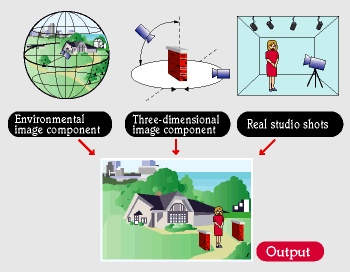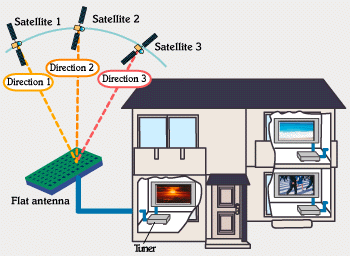 |
|
Image-Based Virtual Studio NHK Science & Technical Research Laboratories have been promoting research and development of efficient program production technology which makes the best use of computer technology. As part of the research, we have developed a new type of virtual studio system which is based on image components from real pictures instead of CG. A HDTV compliant virtual set can be shot from any desired camera angle and is equipped with zooming functions. Features
 In
a virtual studio, the image
of a studio set is created
by using computer graphics
(CG) combined with the real
images taken by a studio
camera. These combined CG
and real images are synthesized
using a chroma-keying device
for program production.
The CG image in a studio
set is linked to a studio
camera and moved or zoomed
according to camera operation.
This function will provide
a variety of image production
possibilities.
In
a virtual studio, the image
of a studio set is created
by using computer graphics
(CG) combined with the real
images taken by a studio
camera. These combined CG
and real images are synthesized
using a chroma-keying device
for program production.
The CG image in a studio
set is linked to a studio
camera and moved or zoomed
according to camera operation.
This function will provide
a variety of image production
possibilities.
|
|
Multi-Beam Receiving Flat Antenna for Satellite
Broadcasting Satellite broadcasting
services are carried out
using a Broadcasting Satellite
(BS) at 110 degrees east
longitude and three Communication
Satellites (CSs) at 124,
128, and 144 degrees east
longitude. Our Laboratories
have been conducting research
on a flat antenna which
will be capable of receiving
multiple satellite broadcasts
from different orbital
locations.
We are pressing forward with the development of technology that will enable an antenna to adjust to these differences. Additionally, technological development towards miniaturization and product cost reduction will be advanced with the aim of its commercialization.  A
flat antenna is formed by
arranging many small antenna
elements. By receiving radio
waves with each antenna
element and combining them
appropriately, even weak
satellite signals can be
received efficiently. Moreover,
the beam direction of the
antenna can be changed electronically.
A
flat antenna is formed by
arranging many small antenna
elements. By receiving radio
waves with each antenna
element and combining them
appropriately, even weak
satellite signals can be
received efficiently. Moreover,
the beam direction of the
antenna can be changed electronically.
|
 Yuko
YAMANOUCHI, Research Engineer,
Yuko
YAMANOUCHI, Research Engineer,  Takao
MURATA, Senior Research Engineer,
Takao
MURATA, Senior Research Engineer,